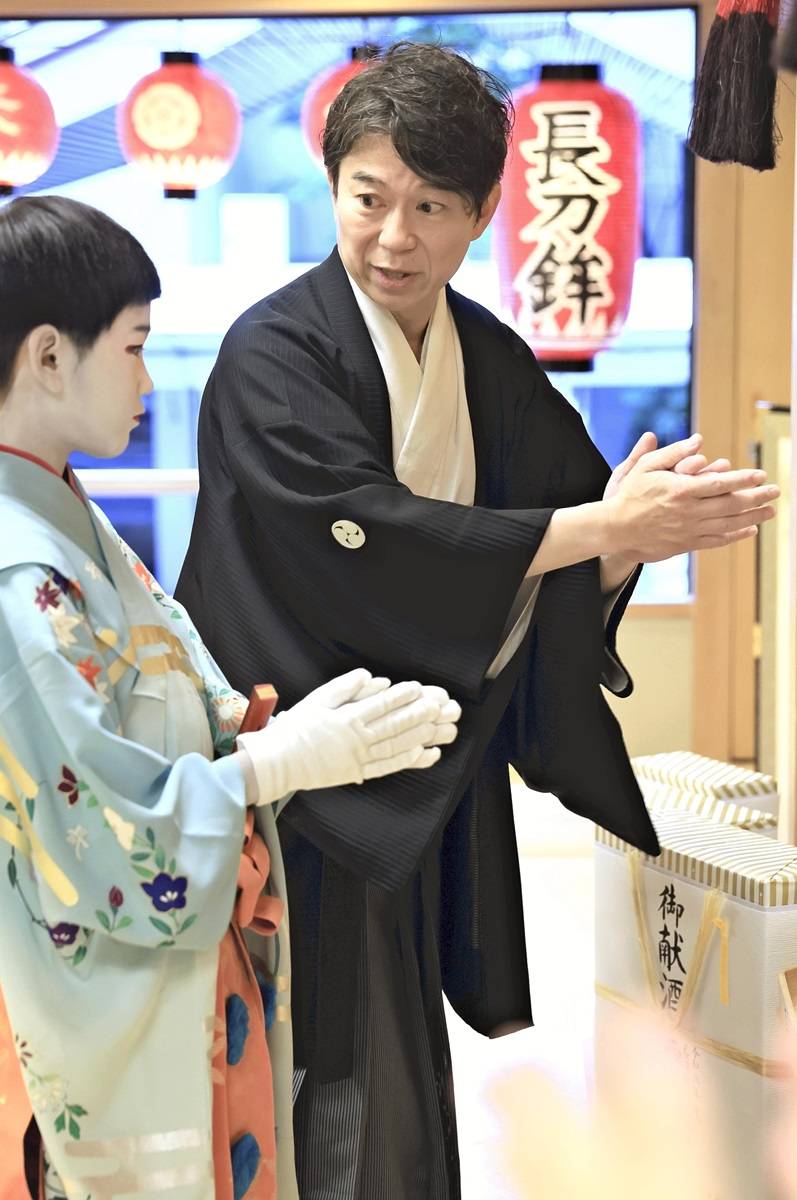
Hiroyuki Ijiri, right, teaches Chigo Masaki Nishikawa the etiquette for praying at Yasaka Shrine on July 1 in Kyoto’s Shimogyo Ward.

23:24 JST, July 31, 2024
KYOTO — The ancient capital was once again filled with colors at the annual Gion Festival in July.
In preparation for the festival, on the afternoon of July 5, a crowd braved the scorching heat of over 36 degrees Celsius to gather on Shijo Street in central Kyoto to watch a ritual boy dance performed on the second floor of a building.
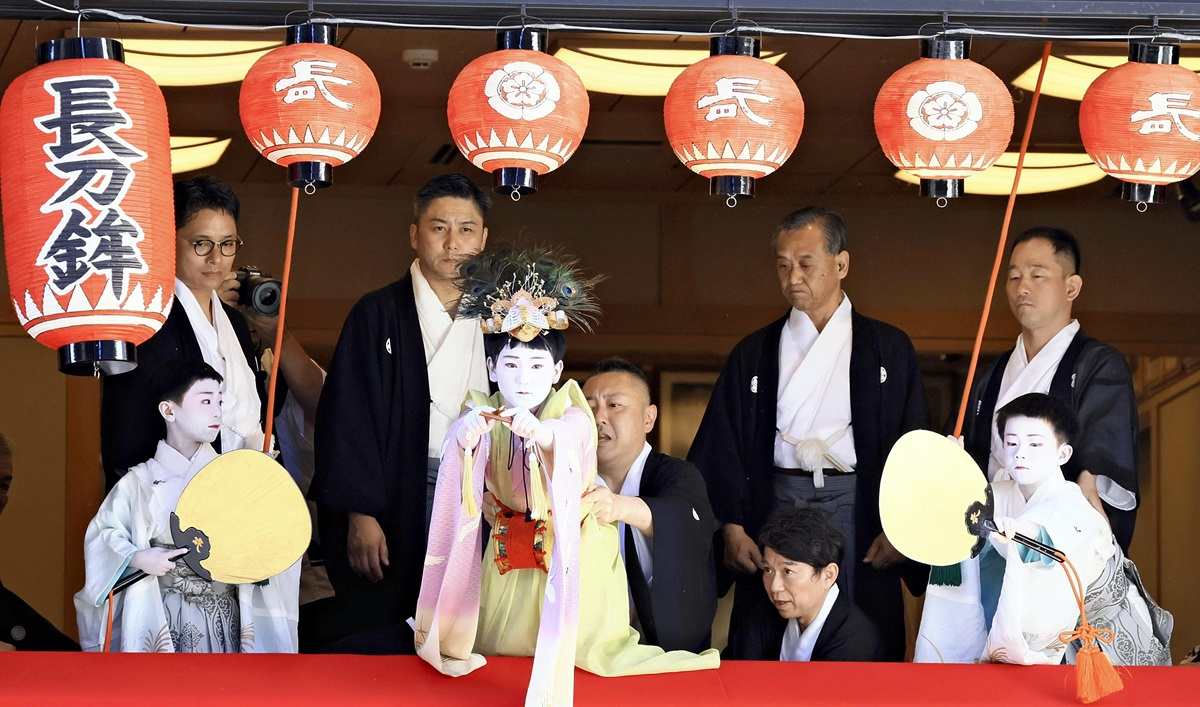
Masaki Nishikawa performs the Taihei no Mai dance at a window on the second floor of a building during a ritual on July 5.
The dance, the first ritual of the festival, would again be performed on the Naginata-hoko float, which leads the other 22 floats in the festival procession each year. The dance began to loud applause from the crowd.
An 11-year-old boy and two assistant boys, aged 7 and 8, leaned out of the windows of the building. They performed the Taihei no Mai (a dance to pray for peace and good health).
The chief performer of the Naginata-hoko float, who is believed to be a messenger of the gods, is called the “chigo”, and the two assistant boys are called “kamuro”.
Hiroyuki Ijiri, head of the team responsible for the chigo and the other boys, watched the performance with enthusiasm. He said the ritual was a rehearsal for the main performance planned for the July 17 procession, with the second-floor window representing the boys’ elevated position on the float.
“If we have confidence in each other and the boys, we can help them overcome their fears,” Ijiri said.
The procession begins with the chigo using a sword to cut the shimenawa (sacred straw rope) that separates this world from the divine. The chigo is considered a sacred being that must be carried by one when moving so that it does not step on the ground.
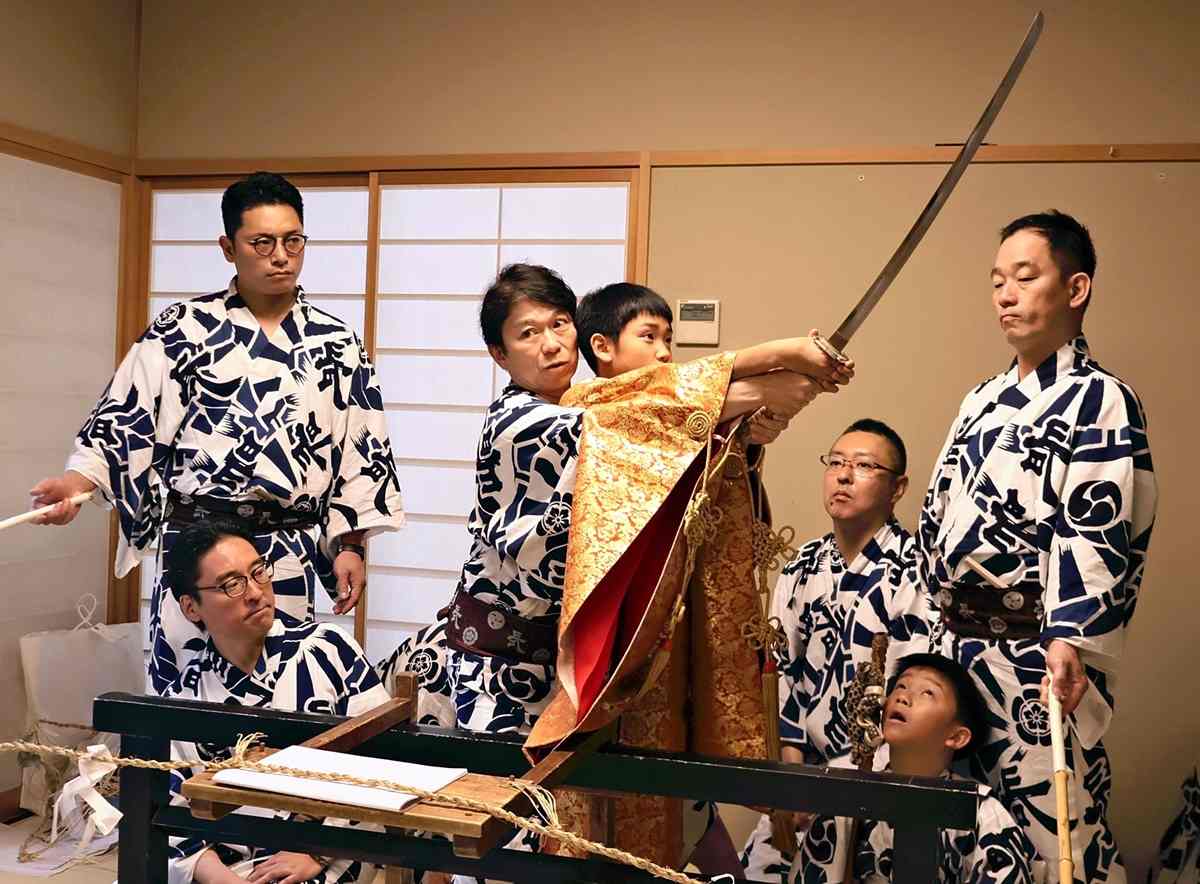
Hiroyuki Ijiri and Masaki Nishikawa, center, practice the shimenawa rope cutting ritual in Kyoto.
Accompaniment of his 21st chigo
A team of four members is responsible for the chigo and the other boys. The team performs various tasks, including tasks related to the selection of artists and assisting artists and their families.
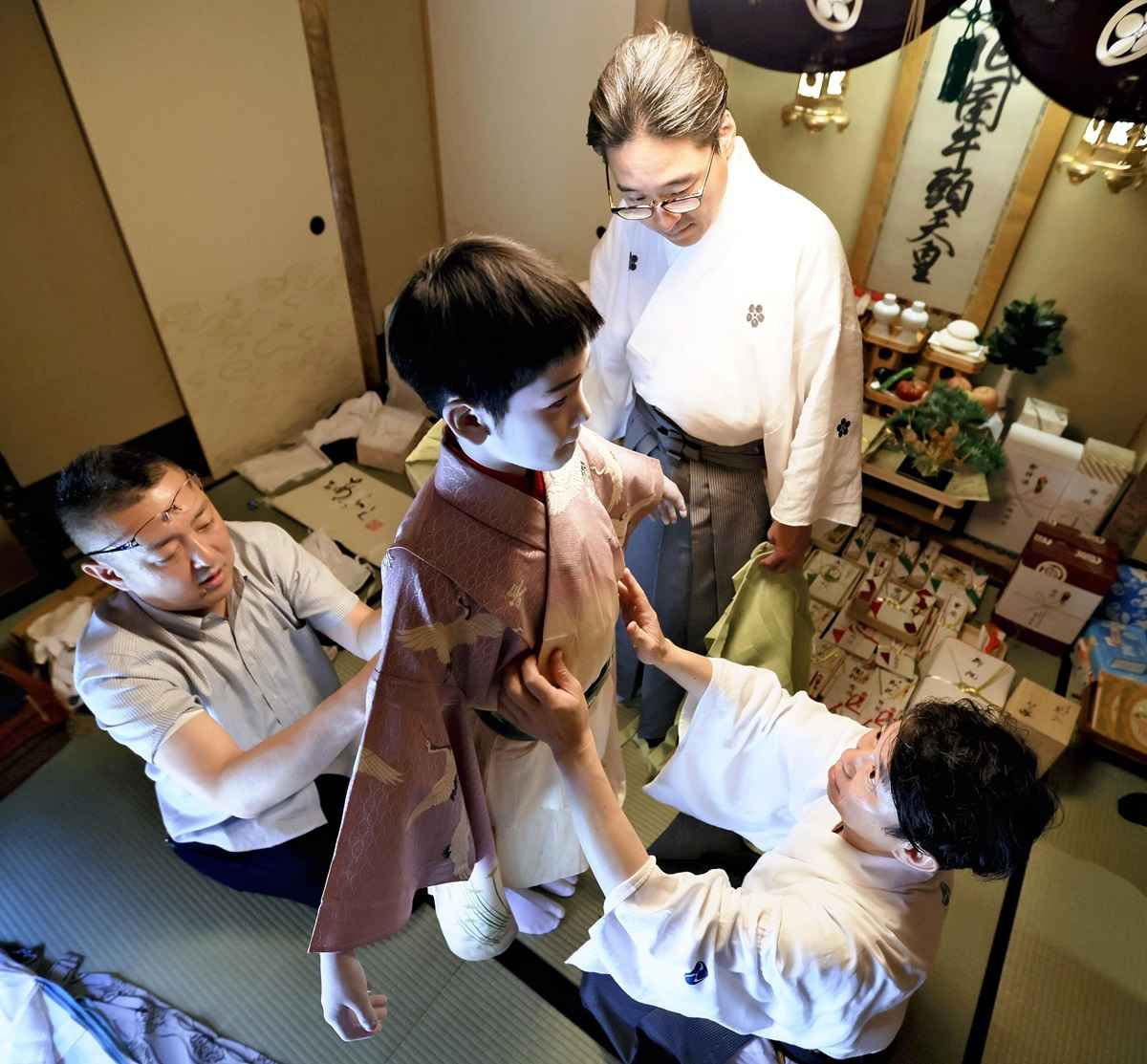
The Chigo team works together to dress up boy Masaki Nishikawa in a festival costume on July 5.
Ijiri is the president of Futaba Kagu, a furniture manufacturer and retailer in Kyoto. He became involved with the float as a musician at the age of 8.
In 1978, when he was in the fourth grade, he was selected as a chigo. He has been a musician ever since. However, his experience as a chigo led to his being named to the chigo team. Masaki Nishikawa, who Ijiri was watching this summer, is the 21st chigo he has sent to the festival.
On July 2, the chigo team held a dance rehearsal for the boys. They were dressed in yukata summer kimonos and practiced for about 90 minutes. The team worked hard to teach them not only the dances, but also the meaning and history of the rituals, movements, and even the ornaments.
In Taihei no Mai, for example, the chigo carries a small drum on his stomach and beats it with sticks, moving them in a large circular motion. The assistant kamuro boys maneuver gold-leafed uchiwa fans in a circular motion.
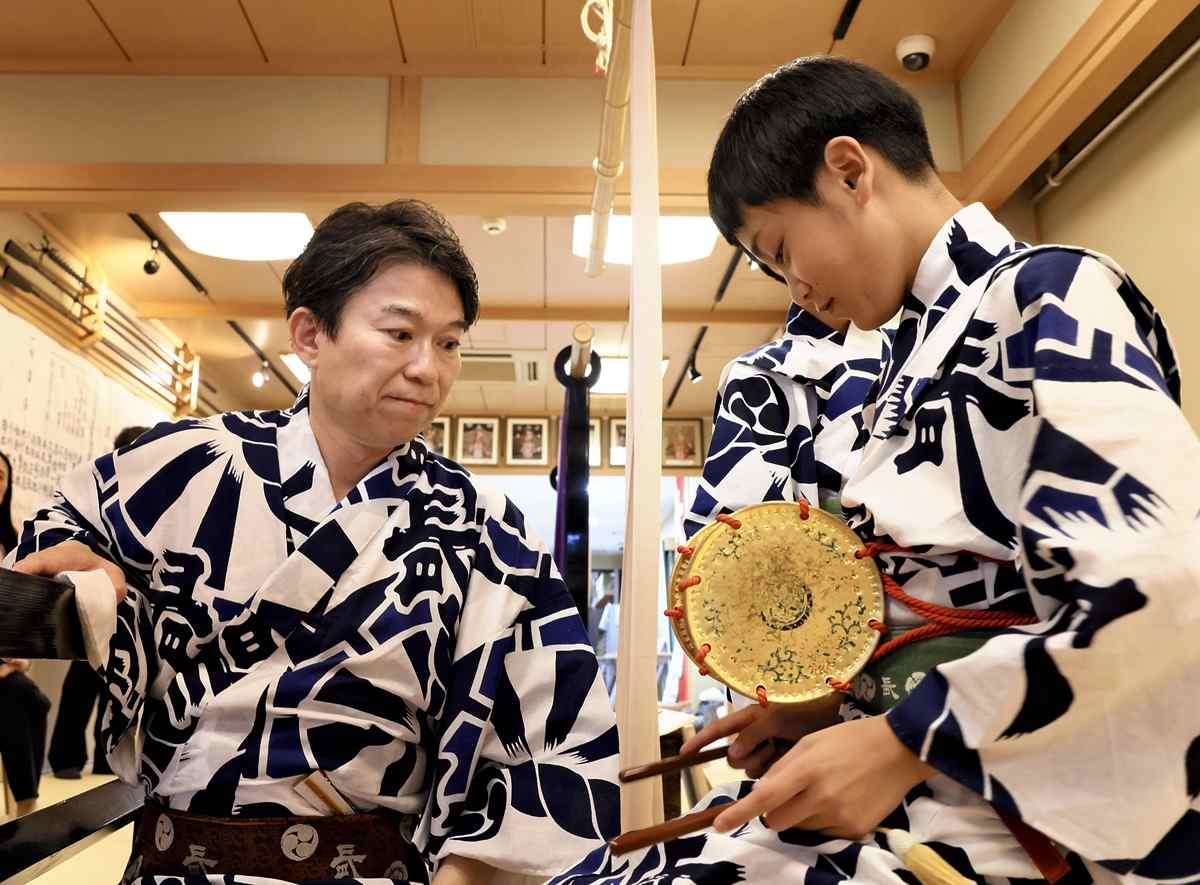
On July 2, Hiroyuki Ijiri teaches the chigo how to beat a drum.
“The chigo symbolizes the moon and the kamuro symbolizes the sun. The float moves forward while purifying evil things with the power of the full moon and the sun,” Ijiri explained to the boys in an easy-to-understand, memorable way.
The boys made their debut in a ceremony on June 12th in which Chigo Masaki Nishikawa was ceremonially adopted as the son of the Naginata-hoko district. That was followed by another ceremony on July 1st in which the boys visited the Yasaka shrine. They also participated in other rituals, including one in which the Chigo becomes a messenger of the gods. Finally, they reached the day of the procession on July 17th.
Using your own experience
When Ijiri meets a new chigo, he recalls his own experiences in that role many years ago: the strings of the crown so tight that it hurt him, and the difficulty he felt when trying to mount a horse while wearing hakama pants. He remembers feeling very sad when the procession was over and he was told, “This is the end.”
Ijiri realizes that his current position requires him to pass on his experiences and the knowledge he has gained from his predecessors and older veterans of the festival to young people.
The strings and obi sash of the festival costumes can cause pain to the children, depending on how they are tied, resulting in interruptions of the ceremonies, so the children must be dressed carefully. Also, some children may cry from stress or the exhaustion of having to perform successive rituals.
“They can’t go on if it’s always hard and demanding. I let them play as much as they want if they’re not seen by the audience,” Ijiri said. He always tries to make them laugh during dance rehearsals. The three boys chosen for this year’s festival had a natural, relaxed expression on their faces at times.
Every year, as the day of the procession approaches, Ijiri notices that the boys’ facial expressions change.
“I could almost say that they were possessed by the gods. I have seen such scenes many times,” Ijiri said. “I will not tell you in detail, because no one believes me.”
The festival began 1,155 years ago as a way for people to pray for the eradication of plagues. After experiencing fear of a rapidly spreading new virus during the COVID-19 pandemic, Ijiri became more aware of the importance of organizing the festival.
On the morning of the float procession, before the Naginata-hoko float leaves, there is time for Ijiri to meet the chigo alone after all the other members have left. Although it only lasts for a few minutes, Ijiri said he loves that moment.

Hiroyuki Ijiri (left) and Masaki Nishikawa spend some time alone before the procession begins in Kyoto on July 17.
“In that quiet atmosphere, I only talk about trivial things with the boys, but I feel a sense of satisfaction,” Ijiri said. “That moment makes me want to stay involved with the chigo.”
***
If you are interested in the original Japanese version of this story, Click here.


